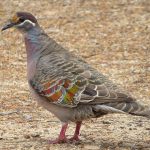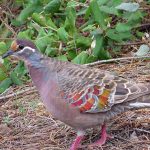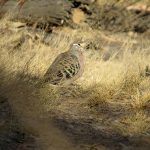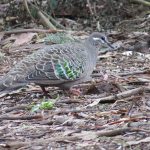COMMON BRONZEWING PIGEON
Common Bronzewing
The Common Bronzewing is one of Australia’s most widespread native pigeons, admired for its subtle beauty and quiet presence in the landscape. While it may not be as flamboyant as some tropical birds, its shimmering wing panels and gentle nature make it a fascinating species to observe.
Appearance
The Common Bronzewing is a medium-sized pigeon measuring 30–35 cm in length with a wingspan of 50–60 cm. Its body is clothed in soft brownish-grey plumage, blending seamlessly with the muted tones of the Australian bush.
- Bronze Wing Patch: The species’ namesake – a striking metallic patch on the upper wings – catches the light with iridescent flashes of bronze, green, and sometimes purple.
- Head & Neck: A cool bluish-grey shade, with a distinctive white crescent-shaped patch on the lower throat.
- Eyes: Vivid, bright red eyes framed by a fine eye-ring.
- Bill & Legs: Both are dark in colour, adding contrast to the more muted feather tones.
Distribution & Habitat
The Common Bronzewing is found across most of Australia, though it is more abundant in the eastern and southern regions. It thrives in a variety of habitats, including:
- Open woodlands
- Eucalypt forests
- Heathlands and scrublands
- Edges of farmland and urban green spaces
They are adaptable, but generally prefer areas with ample ground cover for protection.
Diet & Foraging Behaviour
The Common Bronzewing is granivorous, meaning seeds make up the majority of its diet.
- Primary Foods: Grass seeds, seeds of native shrubs and herbs.
- Occasional Foods: Small fruits and a modest intake of insects, especially during breeding season when protein is valuable.
- Foraging Style: They are ground-dwellers, walking or even running across the forest floor in search of food, their heads bobbing gently as they move.
Behaviour & Temperament
These pigeons are naturally shy and often difficult to approach.
- They prefer to remain still and blend into their surroundings when danger is near, but if startled, they launch into sudden, swift flight, often accompanied by a sharp clapping of wings.
- They are usually seen alone, in pairs, or in small family groups, rather than large flocks.
Breeding & Nesting
Breeding generally happens during the warmer months, though timing can vary with food availability.
- Nest: A simple, flat platform of sticks, often placed in a low tree or dense shrub.
- Clutch: Usually one or two eggs.
- Parental Care: Both male and female share responsibility for incubating the eggs and feeding the chicks with a special nutrient-rich secretion known as pigeon milk.
Interesting Facts
- Incredible Endurance: Common Bronzewings can travel long distances to find water, sometimes flying tens of kilometres in a day.
- Low, Melodic Call: Their call is a slow, mournful “oom” repeated at long intervals – it can carry for over a kilometre across still air.
- Camouflage Masters: Their earthy tones help them remain almost invisible when resting among fallen leaves.
- Iridescent Signalling: The shimmering wing patch is thought to play a role in attracting mates and signalling to other bronzewings in dim light.
- Water Dependence: They must drink regularly and are often seen visiting waterholes at dawn and dusk.
Conservation Status
The Common Bronzewing is currently not considered threatened, thanks to its adaptability and broad range. However, ongoing habitat clearing and predation by introduced species, such as cats, dogs and foxes, pose localised threats. Maintaining healthy woodland habitats and accessible water sources is vital for their continued wellbeing.
The Common Bronzewing is a perfect example of beauty hidden in plain sight. Though quiet and reserved, it reflects the resilience and subtle splendour of Australia’s birdlife. Next time you walk through a patch of eucalypt woodland, pause and listen – the gentle, echoing call of the bronzewing might be closer than you think.





